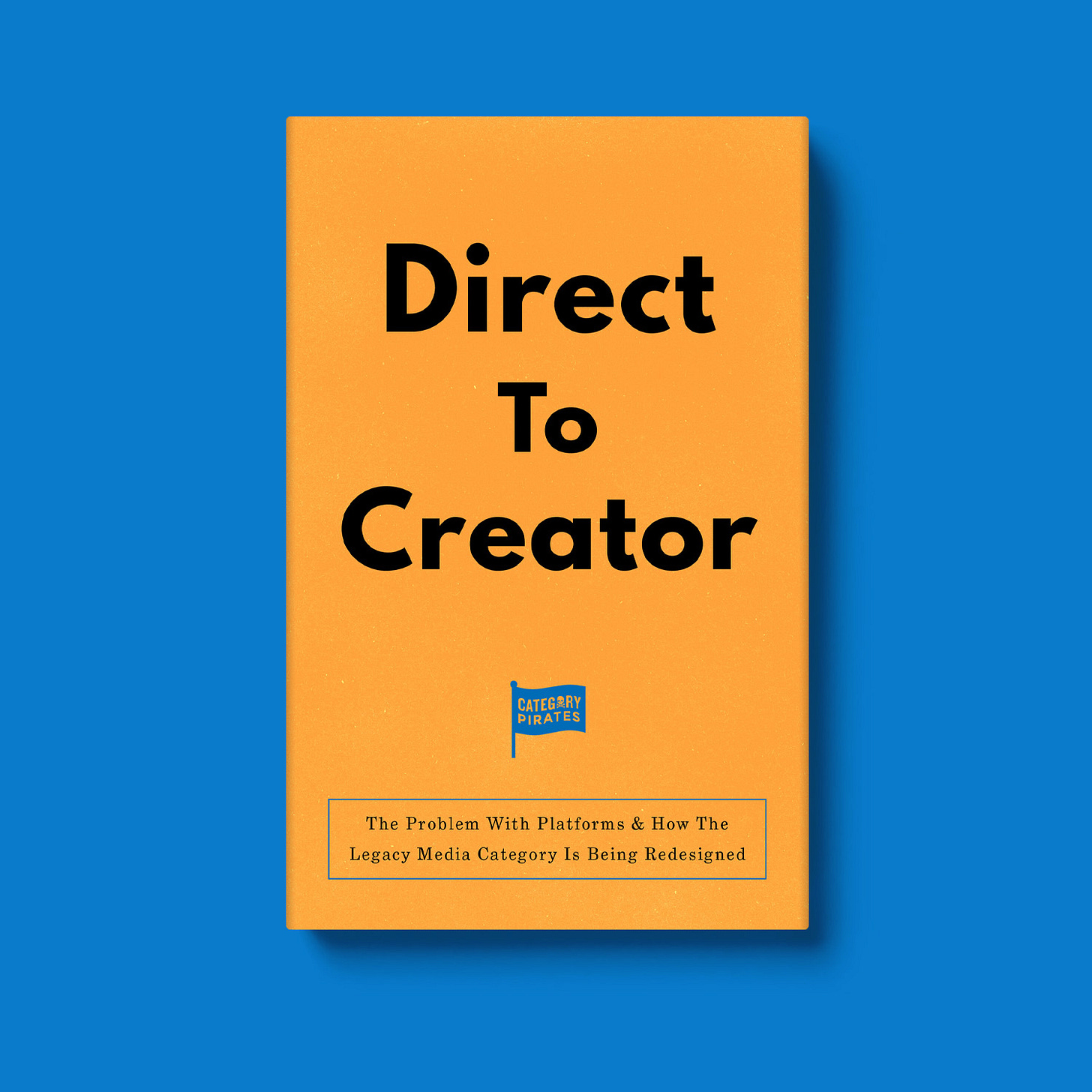The Problem With Platforms: How Direct-To-Creator Is Redesigning Legacy Media & Social Media At The Same Time
If you win when your ecosystem loses, you are not long for this world.
Arrrrr! 🏴☠️ Welcome to a 🔒 subscriber-only edition 🔒 of Category Pirates. Each week, we share radically different ideas to help you design new and different categories. For more: View the mini-book archive | Listen to another category design jam session | Dive into an audiobook | Enroll in the free Category Accelerator email course
Dear Friend, Subscriber, and fellow Category Pirate,
Business media “platforms” and social media platforms have a problem.
The way content gets created, distributed, and monetized today is being radically transformed—and most people haven’t noticed yet. So hop aboard the pirate ship, grab a cocktail or a coffee, and let’s talk about the profound media category change that is going to affect every business, brand, and business person of influence.
We’ll start with Substack.
Do a quick Google search for “Substack”—the venture-backed paid newsletter startup whose “mission is to democratize publishing tools to help writers manage their own subscription-based businesses”—and you’ll see the category battle happening in plain sight:
“Journalists Are Leaving the Noisy Internet for Your Email Inbox” (The New York Times)
“Why We’re Freaking Out About Substack” (The New York Times)
“Substack Offered 6-Figure Advances to NY Times’ Liz Bruenig, Taylor Lorenz” (The Wrap)
“Substack Is A Scam in the Same Way That All Media Is” (NY Mag)
“What Substack Is Really Doing To The Media” (Slate Magazine)
In 2019, Substack raised $15.3 million with high hopes for redesigning the way creators monetized their email lists. Even just two years ago, creating a paid newsletter and running your own content-based subscription business was very difficult (Category Pirate Cole tried, and ended up having to duct-tape a handful of tools together). This was before Twitter jumped on the bandwagon and acquired Revue, a newsletter platform they’re working on integrating into their ecosystem, or before ConvertKit (another email newsletter platform) launched a paid newsletter function. Substack saw a “missing,” a hole in the market caused by the neglect of the media and social platforms, and created a new category out of that neglect.
And they’ve done a legendary job marketing their radically different POV.
So much so that in March of 2021, Substack announced its Series B: a whopping $65M raised at a $650M valuation.
The TechCrunch article announcing the investment refers to Substack’s category as “alt-media” (probably because it would hurt too much to call themselves “legacy media”). Others refer to Substack as Independent Journalism opposed to “Professional Journalism” (whatever that means anymore). Or, more broadly, Substack is one of many new tools and innovations spearheading what is being called The Creator Economy: the part of the Internet where content (and therefore attention) is paid for directly by customers, not indirectly via advertising revenue.
Up until now, creators have not been paid (fairly) for their work. The platforms have been plundering the booty.
There is almost no finer (or more overt) example than pornography.
There’s a quote that has long gurgled in the underbelly of the Internet that if you want a signal for where technology is headed next, just follow porn and gaming. Well, since the dawn of the Internet, porn has been a rough industry for creators. Category Pirate Christopher had former adult actor and now digital media star, Mia Khalifa, on his podcast where she explained how she became one of the most-watched adult performers on the Internet amassing hundreds of millions of views—for which producers paid her only $12,000. Economic servitude is just one type of exploitation that happens in this “behind closed doors” industry.
Now, if you were a savvy porn creator back in the day, you might have launched your own website, served your own content, and processed payments directly. But similar to the problem Substack saw in the world of writing and publishing, the tools for managing a subscription-based video content business have never been easy to use. Instead, many porn content creators have turned to the social-media-equivalent for their industry: cam sites.
Being a porn creator reliant upon cam sites isn’t much different than being a business writer or photographer reliant upon Twitter or Instagram’s algorithms, or a musician relying on Spotify and Apple Music to be discovered. These cam sites do what every other social media platform on the Internet does for its creators: promise exposure (while taking all the cash). It’s then the creator’s responsibility to discern what to do with that exposure, and how to leverage it for their own personal gain—very little of which happened on-platform.
And for a long time, this was seen as the trade-off.
Until OnlyFans came along.
Porn paved the way, but now everyone else is following.




